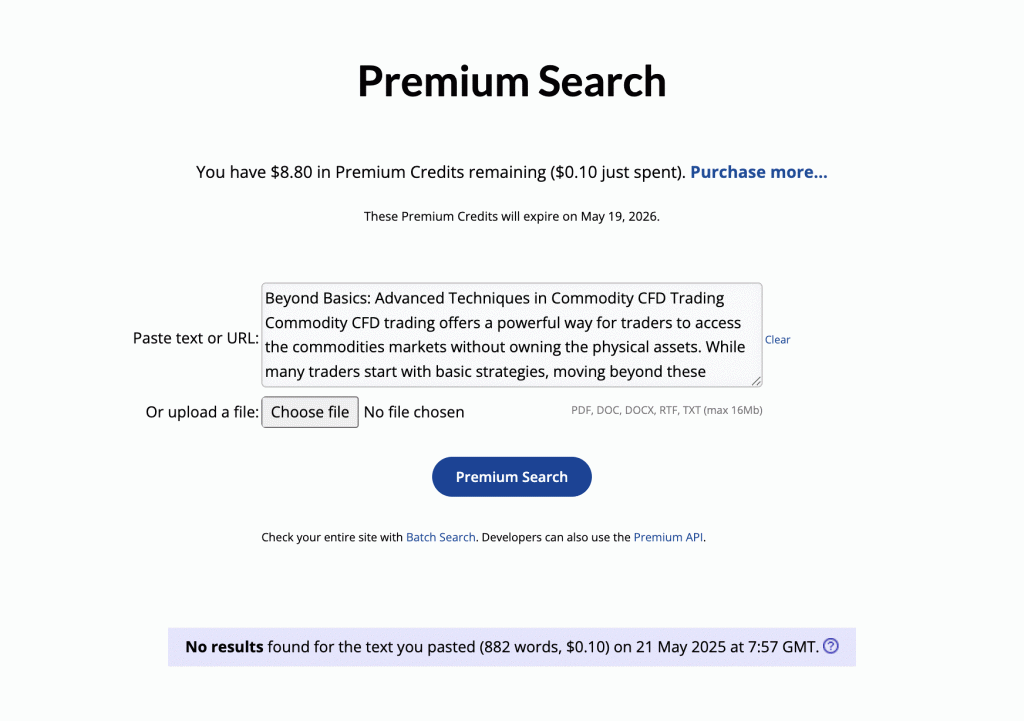Commodity CFD trading offers a powerful way for traders to access the commodities markets without owning the physical assets. While many traders start with basic strategies, moving beyond these foundations is critical for serious traders aiming to consistently profit in often volatile and complex commodity markets.
This article explores advanced techniques that will deepen your understanding, improve your decision-making, and enhance your risk management in commodity CFD trading.
Advanced Technical Analysis for Commodity CFDs
Basic technical analysis is a starting point, but advanced traders employ more nuanced tools and techniques to refine their market timing. Multi-timeframe analysis, where traders examine charts on different scales (e.g., daily, weekly, and monthly), can reveal stronger, more reliable trade signals and prevent being misled by short-term noise.
Volume and open interest data, often overlooked in CFD trading, provide critical insights into market participation and trend strength. A rising price accompanied by increasing volume and open interest typically signals a strong trend, whereas divergence between these can warn of potential reversals.
Advanced chart patterns like the cup and handle or head and shoulders are not just academic; they frequently appear in commodity charts and can predict significant price moves. Using Fibonacci retracements and extensions alongside these patterns helps pinpoint potential support, resistance, and target levels based on historical price swings.
Sophisticated Indicators and Tools
Commodity traders benefit from specialized indicators that capture unique market characteristics. The Commitment of Traders (COT) report is invaluable for understanding the positioning of large speculators and commercial hedgers in futures markets, which often correlate with CFD price moves.
The Average True Range (ATR) measures volatility and assists in setting dynamic stop-loss levels that adjust with market conditions, reducing the chance of being stopped out prematurely during normal price fluctuations.
Combining momentum indicators such as MACD with volatility measures helps clarify trend strength and timing. Similarly, blending the Relative Strength Index (RSI) with Stochastic Oscillators provides complementary insights into overbought or oversold conditions, aiding in precise entry and exit decisions.
Risk Management Strategies Beyond the Basics
Effective risk management separates profitable traders from those who lose capital. Beyond simple fixed percentage risk per trade, advanced traders adjust position sizing based on volatility and correlations. For example, a highly volatile commodity like natural gas warrants smaller positions than a more stable one like gold.
Hedging within commodity CFDs is an advanced technique where traders offset risk in one commodity by taking positions in related ones — such as hedging crude oil risk with heating oil CFDs. This cross-hedging can help smooth portfolio returns and reduce downside exposure.
Stop-loss orders can be refined beyond static levels. Trailing stops that move with favorable price action lock in profits while allowing trades to run. Volatility stops, which adjust based on the ATR, help adapt to changing market dynamics. Conditional orders automate risk management by triggering exits only under specific market conditions.
Managing margin and leverage wisely is paramount, especially in commodity CFDs, where sudden news events can cause large price swings. Advanced traders constantly monitor their margin usage and avoid over-leveraging to prevent forced liquidation during unexpected volatility.
Trading Strategies for Different Market Conditions
No single trading approach fits all market environments. Advanced traders adapt their strategies depending on whether markets are trending, ranging, or reacting to news.
In trending markets, momentum and trend-following strategies work well, capitalizing on sustained price moves. In contrast, mean-reversion strategies aim to profit when prices bounce back from extreme levels, which is often effective in choppy or sideways markets.
Breakout and breakdown strategies seek to enter trades when prices surpass key support or resistance levels, confirmed by volume or momentum signals. Such techniques require discipline to avoid false breakouts.
Seasonality plays a significant role in many commodities. Agricultural products follow planting and harvest cycles, while energy commodities often have predictable demand patterns based on seasons. Advanced traders incorporate these cycles into their timing to improve success rates.
Event-driven trading — such as reacting to inventory reports, geopolitical developments, or OPEC meetings — requires careful planning and risk controls. Volatility spikes around these events can offer high-reward opportunities but also increase risk.
Algorithmic and Automated Trading in Commodity CFDs
Automation offers the advantage of executing complex strategies without emotion and at speeds impossible for human traders. Many commodity CFD traders now use algorithmic systems to capitalize on momentum, mean reversion, or arbitrage opportunities.
Simple algorithms can scan for signals like moving average crossovers or RSI extremes, while more sophisticated systems incorporate machine learning or statistical arbitrage models.
Popular platforms provide tools to build and backtest automated trading strategies tailored for commodity CFDs. However, algorithmic trading also comes with risks: technical failures, overfitting to past data, and market regime changes can cause unexpected losses. Continuous monitoring and adjustment are necessary to maintain effectiveness.
Conclusion
Mastering commodity CFD trading requires moving beyond basic chart reading and simple indicators. Incorporating a deeper understanding of market nuances, advanced technical tools, sophisticated risk management, and psychological discipline sets serious traders apart. Continuous learning and adaptation remain key to thriving in this dynamic market.
For those looking to build a strong foundation before diving into these advanced techniques, a comprehensive commodities trading guide can provide essential knowledge to support your journey.
